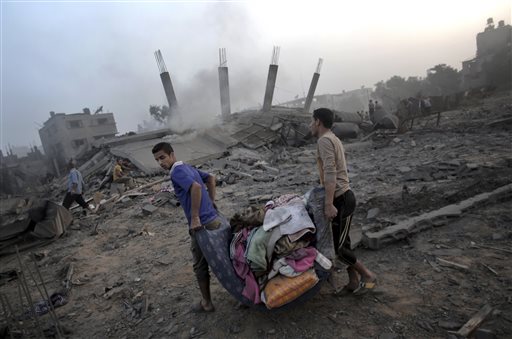The BBC has investigated, and found inaccurate, numerous graphic images which are being shared on social media to show how people in Gaza have been affected by the renewed tensions with Israel.
Hamas has been firing hundreds of rockets from Gaza into Israel, which has responded with airstrikes on selected military targets in Gaza. Several Palestinian militants have been killed, and on Tuesday it was reported that at least 15 Palestinians had been injured.
Over the past week the hashtag #GazaUnderAttack has been used hundreds of thousands of times to distribute pictures claiming to show the effects of the Israeli airstrikes on Gaza’s population.
Some of the images are of the current situation in Gaza, but a #BBCtrending analysis has found that many images date as far back as 2009 and others are from conflicts in Syria and Iraq.
In fact, the BBC underestimates the extent of the misleading nature of news and images emanating from Gaza sources. Blogger Elder of Zion, who has tracked major journalistic failures in past Gaza news coverage, summarizes common mistakes made in reporting on casualties from Gaza:
Mistake #1: Assuming that all Gaza casualties are the result of Israeli airstrikes
The number of Gaza rockets that fall short of Israel and explode within Gaza, or that explode as they are fired, ranges between 35 percent and 80 percent. Also,these rockets are frequently fired from within populated areas.
Between June 12-25, Gaza terrorists fired 41 rockets at Israel, of which 24 exploded in Gaza (killing one child and injuring six). That is a 58 percent failure rate. At least three Gaza civilians have been killed this year alone by terrorist rockets.
When terrorists are firing rockets hurriedly, as they are now, the chances for misfires are even greater. In addition, “work accidents” (which have killed dozens already this year) are likely to occur in Gaza weapons workshops and laboratories.
Also Gaza spokespersons, generally from terror organizations Hamas or Islamic Jihad, are known to blame Israel for deaths in fact caused by their own internal Gaza explosions.
The Israel Defense Forces do not shy away from confirming where they have struck. The rule of thumb is that if Israel denies an airstrike occurred in an area where people were killed, the people were not killed by an Israeli airstrike.
Mistake #2: Believing that victims are civilian when they are not
Over 750 of the 1,166 people killed during 2009’s Operation Cast Lead were terrorists, but Hamas did not publicize the deaths of many of them until months afterwards. As a result, during the operation itself, the media very wrongly assumed that the majority of deaths were civilian. It took a long time to research and crosscheck the identities of the dead and their affiliations.
For all these reasons, journalists must be especially careful when relaying images or reporting on civilian casualties in Gaza.

COMMENTS
Please let us know if you're having issues with commenting.